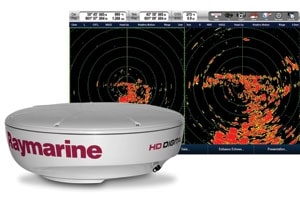
High-definition and digital radars have become the standard. Every manufacturer of marine radar boasts juiced-up signal processing, but that doesn’t mean the units are all the same. Not every fisherman who installs radar on his boat uses it the same way or fishes the same water. The major manufacturers have identified the particular type of fisherman that’s their likely customer and are eager to provide the particular strengths that they feel they bring to the helm. We let four manufacturers brag a little bit, and in doing so, found out where each feels the benefits of its particular radars lie for fishermen.
More Horsepower
Like everyone else, Garmin provides high-definition radar in their latest products. So what’s it mean?
“This is where it gets tricky,” acknowledges director of marine sales Greg DeVries. “It is not something you can quantify.” And while he admits it’s a loose marketing term, it carries some cachet nonetheless. “In Garmin’s world, HD means, for most intents and purposes, eight times the amount of data there is to process in the jump up from our GMR 18 to the GMR 18 HD.”
For center console anglers, says DeVries, “our GMR 24 is an exceptional dome radar with a 3.6-degree bandwidth, and while it won’t pick up individual birds like our xHD open array, it still does very well at tracking flocks of birds. It’s lightweight, not hard on the T-top, and for $1,999, it’s a good buy.”
For the big guns and more hardware, the new xHD units in 4- and 6-foot 6 kW models ($4,499 and $5,299) and 12 kW models ($5,499 and $6,299) “pick up birds at great distances,” says DeVries, “which is important if you are looking for baitfish. These have the highest resolution we offer.”
Strong Legacy
Navico’s broadband radar, with exceptional close-range resolution and low power draw, is still wowing anglers, especially those who focus on inshore work with medium to small center console boats. But the new traditional radar, the HD digital radar coupled to Simrad’s NSE system, is far from antiquated. Inheriting the Northstar tradition of easy operation and commercial functionality under the Navico umbrella, it’s a credit to its legacy.
“Our customers typically know how to use a radar and how to adjust the settings,” says Dennis Hogan, product manager for Simrad. “But we do have full auto for the turn-it-on-and-go people.” To this end, the new radars offer ease of use along with their exceptional resolution.
“We have a couple of screen shots captured using a 4 kW dome that show the radar picking up a school of tuna breaking,” says Hogan. “There is a clear radar return identified as a MARPA [mini automatic radar plotting aid] target, and behind that are tuna: black dots but with pretty good resolution. These tuna were 2½ miles away, and we would not have been able to see them without the radar. This is attributable to the signal processing, which enables us to clear out the signal on the receiving end.”
High-Tech Front-End

Furuno, with a strong commercial marine legacy, continues to fine-tune the efficiency of its radars. The meat and potatoes of differentiating a target happens on the analog side, says Bill Haynes, deep-sea product manager. “HD and digital are marketing terms – with an LCD, anytime you render a target, it is digital radar,” he says. The real science happens on the microwave front-end assembly receiver. “We still send out a signal, it bounces back, and we listen to the signature,” he says. “But the front-ends dig deeper now than they used to when they listen to the return.”
This deeper listening, what Furuno calls the low-noise front-end, allows for complex differentiation and resolution. “Say you are out sailfishing, keeping an eye on squalls,” says Haynes. “You see the weather on your radar, but you want to see boats inside the squall. You need a radar good enough to detect a boat in a squall, one that can eliminate the rain, and that’s tough to do. So we continue to improve our rain-clutter suppression. Furuno receivers do it right.”
Across the Board
Raymarine has recently introduced new radomes that bring the power of digital processing developed in open-array systems into the smaller, more economical HD Digital Radome scanners, including the 18-inch RD418HD Digital Radome Scanner ($2,640) and the 24-inch RD424HD ($2,860). “Now we have our HD digital signal processing technology across the board,” says Brian Vlad, Raymarine’s global product manager.

Resolution and definition are tremendously improved with digital signal processing. “We are looking beneath the noise floor to characterize target information by knowing the shape or form of the target rather than by putting a limiting filter on the signal,” says Vlad. “This is the essence of digital.”
In addition, the new radomes can maximize the tracking of two different ranges at once on the same screen. “We can optimize each range with respect to gain levels, so the pulse for each separate range carries its own set of parameters and adjustments,” he says. Both new radomes also automatically track short-range targets inside of 3 nm with a 48 rpm sweep. This keeps fast boats from sneaking up on you between radar scans, providing an updated image twice as quickly as 24 rpm scans.









